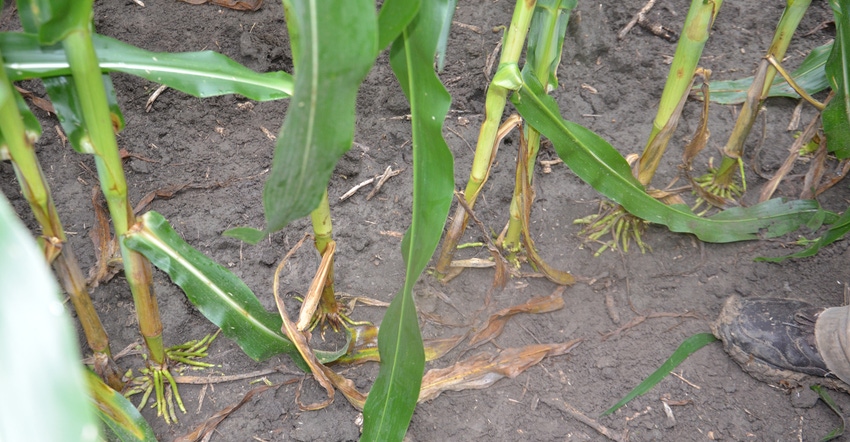
How will the 2019 corn crop finish out the year? Some fields are already in the bin, and yield results are mixed. At the same time, many fields are still standing and in various stages of maturity. Poor rooting noted during the season and dry weather in various areas at various times leave question marks as to how the remaining corn crop will respond if it must stand in the field for a while, and what numbers will appear on the yield monitor when it’s finally harvested.
Even the Crop Watch ’19 field, which was planted May 28 and has looked better than most fields all season, still leaves a bit of uncertainty. Pictures from an unmanned aerial vehicle flying over it a few weeks ago indicate the field is not 100% uniform. There are some lighter-colored streaks in a few areas. Rooting has been questionable all season, and the field was dry at times during July and August — although it received more timely rains, especially in late August and early September, than some other areas.
“The combine will make the final determination,” Dave Nanda says. He is director of genetics for Seed Genetics-Direct, Jeffersonville, Ohio. Seed Genetics-Direct sponsors Corn Watch ’19.
Rooting concerns
Relatively early in the vegetative part of the growth cycle, well before tasseling, Nanda noticed there didn’t seem to be as many brace roots as normal on most plants in the field. There are two hybrids in the field, and the brace root pattern seemed consistent in both hybrids.
“Occasionally you can find a plant without any brace roots at all,” Nanda says. “We also saw a few plants which elbowed but stayed upright, going back to midseason. I believe it was tied to rooting issues, not insect feeding or any other cause.”
Corn rootworm feeding can cause plants to elbow or fall over later in the season. However, Nanda doesn’t believe corn rootworm is the culprit in this case. Instead, he suspects two factors: soil compaction and saturated soils through most of June.
Soil compaction was a cost of doing business on most soils this year, Nanda says. Very few producers have reported planting into soils that they thought were at the ideal moisture level. The Corn Watch ’19 field received so much rain in mid- to late June that a tiny corner of it was underwater, although plants survived. The area received about 5 inches of rain over 10 days, beginning June 15. It rained every day, keeping soils saturated.
Other agronomists have reported poorer-than-normal rooting, especially related to brace roots. The reports go across hybrids and companies and come in from various areas of the eastern Corn Belt.
Dry weather
Look closely at the picture above. It rained the day before and even drizzled the morning Nanda made this field visit. However, before that, in parts of July and August, there were dry stretches in the field. Big cracks were still visible in places, even though it had just rained.
How dry weather will impact this field and other fields remains to be seen. Some speculate it may lead to smaller kernel size. Nanda suspects that will depend largely upon timing of the rains that did occur. Rainfall patterns were extremely variable over the past six weeks.
Nanda will revisit the field soon to gauge maturity and get a feel for yield potential.
About the Author(s)
You May Also Like




